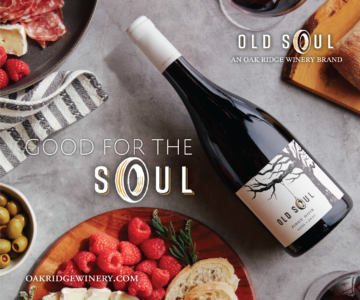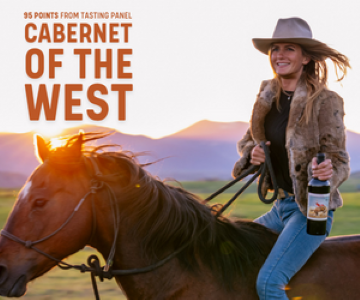
THE THIRD ANNUAL INTERNATIONAL CANNED WINE COMPETITION PROVED THAT QUALITY IS ON THE RISE
by Jonathan Cristaldi

Held over three days in July, the third annual International Canned Wine Competition went off without a hitch at the Mendocino County Fairgrounds in Boonville, California. More than 300 canned wines from around the globe were sampled blind, and by the pop of the last can, a show-stopping, standing-ovation-worthy lineup of 85 gold medals had been handed out—and fortunately, I was there to bear witness.
But days before I was due to judge the competition, I was frantically emailing its director, Allan Green, wondering if he possibly had a replacement. Why? A technological failure—somehow the dates of the competition never made it on my calendar, and with the new wave of COVID infections, finding child care for my 5-year-old daughter was proving difficult, to say the least.
Green relayed that there were no backups; they really needed me there. I resolved to bring my daughter if I had to (after all, she’s already got quite a gifted nose and can plainly tell the difference between Chardonnay and orange juice). Luckily, I found a willing relative to watch her, and in retrospect, I’m so glad it worked out, because I was left stunned and impressed by the level of quality and plan to actively seek out new discoveries in the category.
The first International Canned Wine Competition took place in 2019, but “I had been following the progress of canned wine since I started collecting wine cans in 1980,” explains Green, who presently has well over 2,000 cans in his collection. “I saw the category expanding and thought it would be beneficial for the producers of canned wine to have their own showcase; they had been an afterthought in wine competitions up to that point.”
Indeed, the canned-wine category has all but exploded in recent years: It’s the kind of thoroughbred horse that would take the Triple Crown on its first go-around. Nielsen data from August 2020 posited that the biggest growth during the COVID crisis had occurred in canned spirits (140% in off-premise accounts), which prompted canned wine to actually experience a slowdown. But what a difference a year makes. A report published in July 2021 in Shanken News Daily put the number of U.S. producers of canned wines at around 580, with over 1,400 SKUs; sales, meanwhile, were “up 62% over the previous 12 months.”
But statistics were far from my mind when I met with my fellow judges in Boonville. The empty fairgrounds offered an expansive, peaceful place to sample wines from 17 different countries, including France, Italy, Spain, Argentina, Australia, New Zealand, England, India, and, of course, the United States.

PHOTO COURTESY OF THE INTERNATIONAL CANNED WINE COMPETITION
The blind tasting rounds were fast and furious, with good debate, and I really found a tremendous amount of depth and complexity in many of the samples. Sure, a couple “made me wince,” per my tasting sheets, but others were “rich and quite nice to drink.” One in particular—the 2020 Alloy Wine Works Hans Gruner from California, which earned Best of Show and a gold medal—sported a “surprisingly lush” quality, with “richness, loads of citrus flavors, [and a profile that’s] a touch off-dry, zippy, zingy, and thoroughly enjoyable.”
Heads up, buyers! The three other Best of Show winners in addition to the Alloy Wine Works Hans Gruner were the Solid Ground Winery Ria Sparkling Rosé from California; the Joie Farms 2020 Tsunami Rosé from Canada; and the Canned Oregon Pinot Noir from Oregon. British producer Kiss of Wine, meanwhile, earned the most medals in the competition with its four honors.

After reflecting on the experience, I asked Green if he had any insights into the improved quality of canned wines. “I believe a major factor has been the development of portable canning lines, enabling small wineries to efficiently can small lots of wine,” he says. “Some new small, high-quality producers don’t produce bottles at all, just cans. These producers focus on sophisticated label designs and packaging materials with high-end wines to match. This is a recent trend that demonstrates a shift in the perception of the quality of wine in cans.”
Green’s point was not lost on me. I can think of three companies in a heartbeat that are producing canned wines I regularly stock myself: Sean Larkin’s utterly mesmerizing Larkan (he makes my all-time-favorite canned Merlot); Josh Phelps’ juicy, easygoing, light-alcohol Space Age Rosé Spritz; and WEST + WILDER from Matthew Allan and Kenny Rochford, which is so good yet so tough to find that I buy it anywhere I see it.
And that’s perhaps the dilemma. As more and more consumers are becoming aware that quality in canned wines is on the up and up, they are also learning that some of the more serious examples are still relatively limited in availability (although Hans Gruner, one of the larger-production canned wines, is blowing that argument out of the water). Still, Green asserts, “The competition can shine a light on products from all over the world that otherwise may not have access to significant exposure in the marketplace.”
To that, I respond: Absolutely. For those among you who are producers of canned wine, make sure you enter your wares into the fourth annual International Canned Wine Competition. If you do, your canned wine could soon be sporting a gold medal and Best in Show honor, which, as the competition increases, could make all the difference for those vying for prime shelf (and cooler) space. For more information, visit cannedwinecompetition.com.

